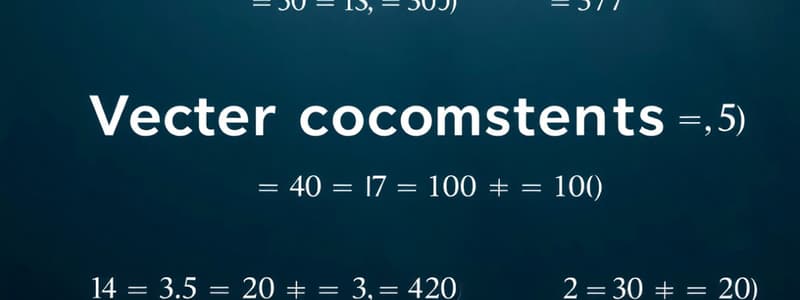Podcast
Questions and Answers
What is the formula for calculating the x-component of a vector?
What is the formula for calculating the x-component of a vector?
- $Ax = A cos \theta$ (correct)
- $Ax = A tan \theta$
- $Ax = A sin \theta$
- $Ax = A + \theta$
Under what condition can the equations for vector components be applied accurately?
Under what condition can the equations for vector components be applied accurately?
- If θ is measured with respect to the y-axis
- If the vector has equal x and y components
- If θ is measured with respect to the x-axis (correct)
- If the vector's magnitude is greater than zero
What distinguishes a vector from a scalar?
What distinguishes a vector from a scalar?
- Scalars can be represented by arrows.
- Vectors solely have magnitude.
- Vectors contain magnitude and direction. (correct)
- Scalars have both magnitude and direction.
What happens to the x-component and y-component of a vector when θ equals 90°?
What happens to the x-component and y-component of a vector when θ equals 90°?
Which of the following is a scalar quantity?
Which of the following is a scalar quantity?
If $Ax$ is negative, which of the following can be inferred about the angle θ?
If $Ax$ is negative, which of the following can be inferred about the angle θ?
What is required to properly define a vector quantity?
What is required to properly define a vector quantity?
What is the relationship between the components of a vector and its magnitude?
What is the relationship between the components of a vector and its magnitude?
How is the magnitude of a vector denoted?
How is the magnitude of a vector denoted?
Which of the following statements is true about vector quantities?
Which of the following statements is true about vector quantities?
What happens to the order of magnitude if the multiplier in scientific notation is greater than 3.162?
What happens to the order of magnitude if the multiplier in scientific notation is greater than 3.162?
In estimating the number of breaths taken during a lifetime, why is 10 breaths per minute a better estimate than 1 or 100?
In estimating the number of breaths taken during a lifetime, why is 10 breaths per minute a better estimate than 1 or 100?
Which of the following is NOT considered a significant figure?
Which of the following is NOT considered a significant figure?
Why is it important to consider uncertainty in measurements?
Why is it important to consider uncertainty in measurements?
Which of the following statements about significant figures is true?
Which of the following statements about significant figures is true?
Which of the following statements about dimensional analysis is true?
Which of the following statements about dimensional analysis is true?
In the equation s = a + b, what are the dimensions of s if a and b have units of meters?
In the equation s = a + b, what are the dimensions of s if a and b have units of meters?
How would you convert a speed limit of 100 km/h to miles per hour?
How would you convert a speed limit of 100 km/h to miles per hour?
If a car is traveling at 38.0 m/s, what is its speed in kilometers per hour?
If a car is traveling at 38.0 m/s, what is its speed in kilometers per hour?
Which prefix corresponds to 10 raised to the power of 6?
Which prefix corresponds to 10 raised to the power of 6?
What is the correct order of magnitude for the mean radius of the Earth, approximately 6,371 km?
What is the correct order of magnitude for the mean radius of the Earth, approximately 6,371 km?
If the conversion from miles to kilometers uses 1 mile = 1.609 km, what is the equivalent of 200 miles in kilometers?
If the conversion from miles to kilometers uses 1 mile = 1.609 km, what is the equivalent of 200 miles in kilometers?
Which of the following is an example of a unit that can cancel in dimensional analysis?
Which of the following is an example of a unit that can cancel in dimensional analysis?
When adding two vectors graphically, where is the resultant vector drawn?
When adding two vectors graphically, where is the resultant vector drawn?
What does vector subtraction involve?
What does vector subtraction involve?
Which of the following describes a vector?
Which of the following describes a vector?
In the polygon method for adding vectors, what should be done after drawing the first vector?
In the polygon method for adding vectors, what should be done after drawing the first vector?
What is necessary to accurately describe a vector algebraically?
What is necessary to accurately describe a vector algebraically?
Study Notes
Components of a Vector
- A component is a part of a vector.
- Rectangular components are the projections of a vector along the x and y-axes.
- The x-component of a vector is the projection along the x-axis.
- The y-component of a vector is the projection along the y-axis.
- The components can be positive or negative and will have the same units as the original vector.
Dimensional Analysis
- Necessary to either derive a math expression or equation or to check its correctness.
- Quantities can be added/subtracted only if they have the same dimensions.
- The terms of both sides of an equation must have the same dimensions.
Conversion of Units
- Units can be treated like algebraic quantities that can cancel each other out.
Prefixes
- Prefixes correspond to powers of 10.
- Each prefix has a specific name and abbreviation.
Estimates and Order-of-Magnitude Calculations
- Order of magnitude is a power of ten determined by expressing the number in scientific notation.
- If the multiplier is less than 3.162, the order of magnitude of the number is the power of 10 in the scientific notation.
- If the multiplier is greater than 3.162, the order of magnitude is one larger than the power of 10 in the scientific notation.
Uncertainty in Measurements
- There is uncertainty in every measurement.
- This uncertainty carries over through calculations.
- Significant figures are used to approximate the uncertainty in results of calculations.
Significant Figures
- A significant figure is one that is reliably known.
- It is the number of numerical digits used to express the measurement.
- All non-zero digits are significant.
- Zeros are significant when they are between other non-zero digits, after the decimal point and another significant figure, or can be clarified by using scientific notation.
Vector and Scalar Quantities
- A vector quantity has both magnitude and direction.
- A scalar is completely specified by only a magnitude.
- Vectors can be described by their magnitude and direction and by their components.
Adding Vectors Graphically
- When adding multiple vectors, the resultant is drawn from the origin of the first vector to the end of the last vector.
Adding Vectors Geometrically (Polygon Method)
- Draw the first vector with the appropriate length and direction.
- Draw the next vector with the appropriate length and direction, starting at the end of the first vector.
- Continue drawing vectors, starting at the end of the previous vector.
- The resultant is drawn from the origin of the first vector to the end of the last vector.
Vector Subtraction
- Vector subtraction is a special case of vector addition involving the negative of the subtracted vector.
- Continue with standard vector addition procedure.
Describing Vectors Algebraically
- Vectors can be described by their magnitude, units, and direction.
- Vectors can be described by their components.
Studying That Suits You
Use AI to generate personalized quizzes and flashcards to suit your learning preferences.
Related Documents
Description
Test your knowledge on vector components, dimensional analysis, unit conversions, and order-of-magnitude calculations. This quiz covers essential concepts in physics that are fundamental to understanding how to manipulate and interpret physical quantities.




